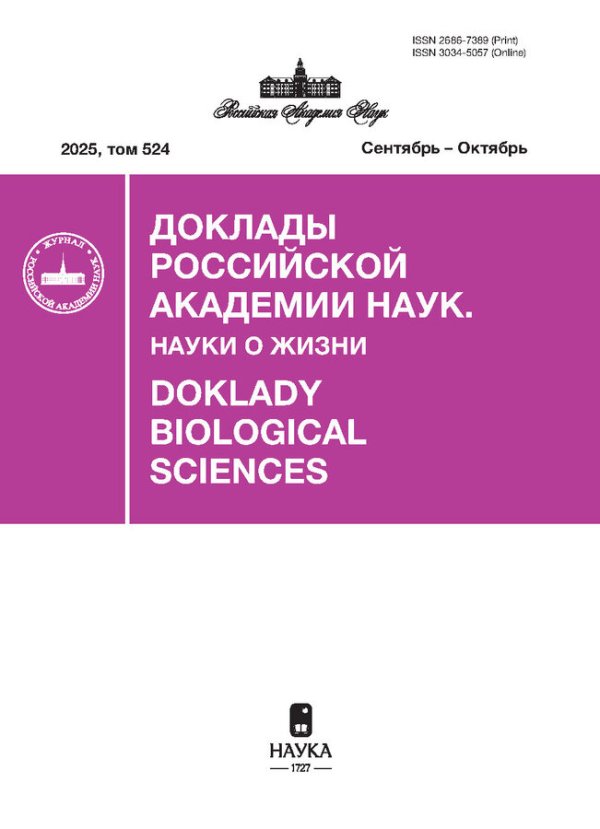Исследование функциональной роли in vivo мутаций в ВТВ домене белка СР190 Drosophila melanogaster
- Авторы: Федотова А.А.1, Георгиев П.Г.1, Бончук А.Н.1
-
Учреждения:
- Федеральное государственное бюджетное учреждение науки Институт биологии гена Российской академии наук (ИБГ РАН)
- Выпуск: Том 509, № 1 (2023)
- Страницы: 177-180
- Раздел: Статьи
- URL: https://journals.rcsi.science/2686-7389/article/view/135648
- DOI: https://doi.org/10.31857/S2686738922600868
- EDN: https://elibrary.ru/LZNLTA
- ID: 135648
Цитировать
Полный текст
Аннотация
Транскрипционный фактор СР190 дрозофилы является одним из ключевых белков, определяющих активность промоторов генов домашнего хозяйства и инсуляторов. CP190 имеет N-концевой ВТВ домен, обеспечивающий димеризацию. Большая часть из известных архитектурных белков дрозофилы взаимодействуют с гидрофобной пептид-связывающей бороздкой в ВТВ домене, что, как предполагается, является одним из механизмов привлечения СР190 на регуляторные элементы. Для исследования роли ВТВ домена во взаимодействии с архитектурными белками были получены трансгенные линии, экспрессирующие варианты СР190 с мутациями в пептид-связывающей бороздке, что нарушает их взаимодействие с архитектурными белками. В результате проведенных исследований было выяснено, что мутации в ВТВ домене не влияют на связывание белка СР190 с политенными хромосомами. Таким образом, наши исследования подтверждают полученные ранее данные о том, что СР190 привлекается на регуляторные элементы при помощи нескольких транскрипционных факторов, взаимодействующих помимо ВТВ с другими доменами СР190.
Ключевые слова
Об авторах
А. А. Федотова
Федеральное государственное бюджетное учреждение науки Институт биологии гена Российской академии наук (ИБГ РАН)
Email: bonchuk_a@genebiology.ru
Россия, Москва
П. Г. Георгиев
Федеральное государственное бюджетное учреждение науки Институт биологии гена Российской академии наук (ИБГ РАН)
Email: bonchuk_a@genebiology.ru
Россия, Москва
А. Н. Бончук
Федеральное государственное бюджетное учреждение науки Институт биологии гена Российской академии наук (ИБГ РАН)
Автор, ответственный за переписку.
Email: bonchuk_a@genebiology.ru
Россия, Москва
Список литературы
- Kyrchanova O., Georgiev P. // Int J Mol Sci. 2021. V. 22. № 2. P. 671.
- Pai C.Y., Lei E.P., Ghosh D., Corces V.G. // Mol. Cell. 2004. V. 16. P. 737–748.
- Cubenas-Potts C., Rowley M.J., Lyu X., et al. // Nucleic Acids Res. 2017. V. 45. № 4. P. 1714–1730.
- Bartkuhn M., Straub T., Herold M., et al. // EMBO J. 2009. V. 28. P. 877–888.
- Sabirov M., Kyrchanova O., Pokholkova G., et al. // Epigenetics Chromatin. 2021. V. 22. № 14 (1). P. 16.
- Plevock K.M., Galletta B.J., Slep K.C., Rusan N.M. // PLoS One. 2015. V. 10. e0144174.
- Bonchuk A., Denisov S., Georgiev P., Maksimenko O. // J Mol Biol. 2011. V. 23. № 412 (3). P. 423–36.
- Oliver D., Sheehan B., South H. et al. // BMC Cell Biol. 2010. V. 11. P. 101.
- Maksimenko O., Bartkuhn M., Stakhov V. et al. // Genome Res. 2015. V. 25. P. 89–99.
- Kyrchanova O., Klimenko N., Postika N., et al. // Biochim Biophys Acta Gene Regul Mech. 2021. V. 1864. № 10. 194733.
- Melnikova L., Kostyuchenko M., Molodina V., et al. // Chromosoma. 2018. V. 127. № 1. P. 59–71.
- Bag I., Chen S., Rosin L.F., et al. // Nat. Commun. 2021. V. 12. P. 4170.
- Sabirov M., Popovich A., Boyko K., et al. // Int J Mol Sci. 2021. V. 22. № 22. 12400.
- Ahmad K., Melnick A., Lax S., et al. // Mol. Cell. 2003. V. 12. P. 1551–1564.
- Ghetu A., Corcoran C., Cerchietti L., et al. // Mol. Cell. 2008. V. 29. P. 384–391.
- Bischof J., Maeda R., Hediger M., et al. // Proc Natl Acad Sci U S A. 2007. V. 27. № 104 (9). P. 3312–7.
- Butcher R., Chodagam S., Basto R., et al. // J Cell Sci. 2004. V. 117. Pt. 7. P. 1191–9.
- Demakova O., Demakov S., Boldyreva L., et al. // Chromosoma. 2020. V. 129. № 1. P. 25–44.
- Zykova T., Levitsky V., Belyaeva E., et al. // Curr. Genomics. 2018. V. 19. № 3. P. 179–191.
- Bertolini M. et al. // Science. 2021. V. 371. P. 57–64.
Дополнительные файлы











